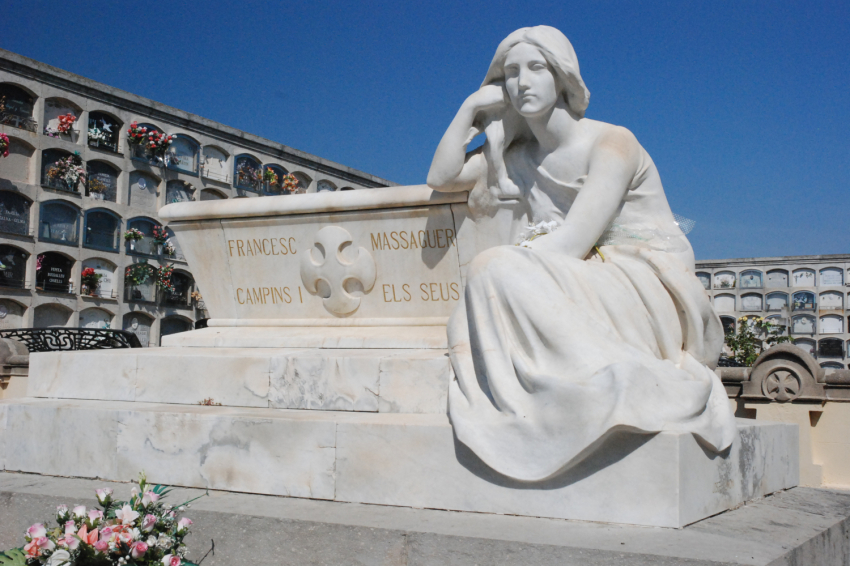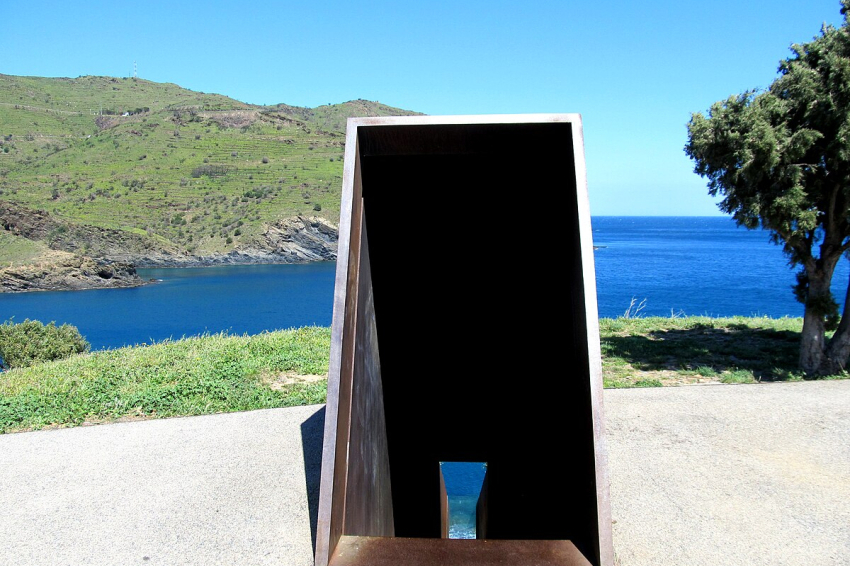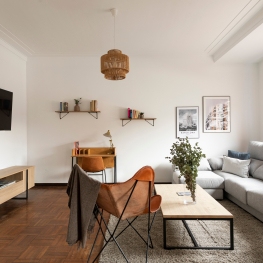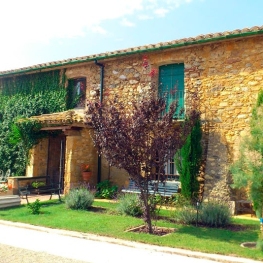The cities of the dead, the most unique cemeteries in Catalonia
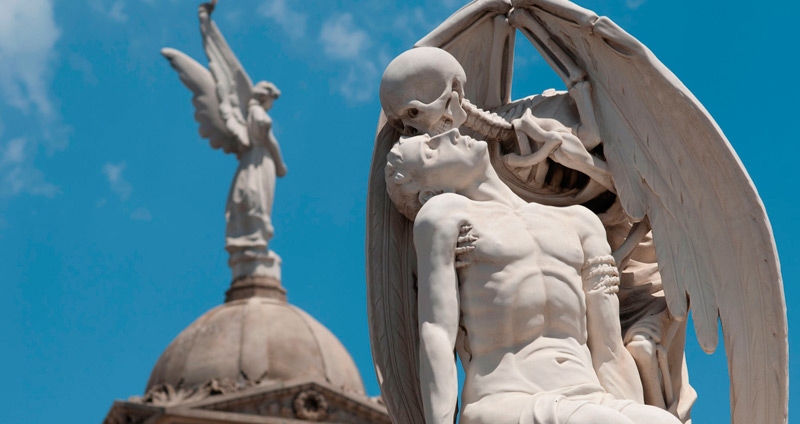
Death is a fact that marks the existence of human beings, walking through a cemetery is to know how people understand and live the end of life. Calls cities of the dead are unknown and lonely space, away from the hustle of daily life of a society that often turns its back on this natural fact. Inside cemeteries often they curiosities and an extensive historical and artistic heritage are hidden.
In this way we will visit several cemeteries in Catalonia, funerary spaces with different characteristics that stand out for their architectural uniqueness, their situation or the stories hidden behind a journey that will take us to Olius, Arenys de Mar, Barcelona, Portbou and Bausen.
The Cemetery of Olius
Near the church of Olius, in the Solsonès region, we find one of the most unique cemeteries in Catalonia, built in 1916 in the Modernist style. This space was designed by Bernardí Martorell i Puig and is characterized by its strong integration with nature.
The cemetery was built in an area of fallen rocks surrounded by holm oaks —elements to which a symbolism was attributed, as the fallen rocks represent death and the green oaks represent life. One of the main characteristics of this space is that it respected the natural environment where it was built, avoiding the classic cemetery layout of rows of niches and cypresses.
Bernardí Martorell was clearly influenced by Gaudí, which can be seen especially in the parabolic arch at the entrance to the cemetery and in the double cross at the top of the funerary space. Another curiosity of this site is that the tombs and mausoleums are carved directly into the rock.
The cemetery of Olius is an example of harmony between nature and architecture, a place where Modernist funerary art achieved one of its most interesting expressions. Over the years, the cemetery has preserved its original structure without breaking or damaging the authenticity of the space.
Arenys de Mar Cemetery
The cemetery of Arenys de Mar could be considered the literary cemetery of Catalonia, thanks to the poet and writer Salvador Espriu, who turned it into a mythical and literary setting in his work “Cementiri de Sinera”. The literary universe of Espriu has, therefore, in this place an important reference, reflected in verses such as: “I will walk through the order of green cypresses, motionless above the calm sea.”
But beyond its literary side, the Arenys cemetery is also a fine example of a Mediterranean seaside cemetery. It is located on top of the Hill of La Pietat (Piety), and one of its most famous views is from the entrance path, where, turning toward the gate, one can see the Mediterranean Sea framed by cypresses.
The cemetery was inaugurated in 1868 next to the Chapel of La Pietat. It is divided into three large terraces crossed by an avenue of cypresses. The first two terraces are surrounded by niches, while the third contains the mausoleums built by wealthy families such as industrialists or “Americans.” Here, funerary art reaches its peak with sculptures created by Josep Llimona, Frederic Marès, and Venanci Vallmitjana.
Returning to the cemetery's literary aspect, one can find the niche where Salvador Espriu is buried —number 381— at the end of the second terrace on the left-hand side. It can be reached along the cemetery path, lined with cypresses that rise above the sea. From the top of the hill, visitors can see the town and other coastal spots surrounding Arenys de Mar.
Poblenou Cemetery
In this neighborhood of Barcelona stands the first cemetery built outside the city walls. Until then, burials took place in cemeteries beside churches. The construction of this cemetery sought to end that practice, as burying the dead inside such a densely populated city as Barcelona created hygiene problems and was a source of epidemics.
It was inaugurated in 1775, but in 1808 the site was destroyed during the French invasion. In 1819, it was rebuilt in its current location. Poblenou Cemetery was also known as the Eastern or Old Cemetery, since it preceded the newer Montjuïc Cemetery. The reconstruction followed a neoclassical design by the Italian architect Antonio Ginesi. His plan consisted of two intersecting streets forming four large burial sections, with a monument at their crossing dedicated to the victims of the yellow fever outbreak that struck Barcelona in 1821.
Other notable features include the front section with a garden and four compartments, the main gate flanked by two obelisks decorated with sculptures symbolizing Faith and Hope—by F. Pagès Serratosa—and the angel above the portico, sculpted by the Vallmitjana brothers. As in many cemeteries, the mausoleum area is the most artistically impressive. Here, the Barcelona bourgeoisie also sought to display their power through elaborate tombs and pavilions. Among the many funerary sculptures, the most emblematic is “The Kiss of Death”, created in 1930 by Jaume Barba.
Poblenou Cemetery also holds the graves of several distinguished figures, such as composer Josep Anselm Clavé, writer Serafí Pitarra, and members of the noble Maldà family of Barcelona.
Beyond its historical figures, one of its most popular sites is the tomb of “El Santet”. This nickname refers to Francesc Canals, who died in 1899 at the age of 22. In life, he was loved by all who knew him and was said to have supernatural abilities. Soon after his death, devotion to his tomb began, as people believed he granted favors. This popular veneration has continued to the present day.
Portbou Cemetery
The cemetery of Portbou is located in an area of great beauty, as, like other seaside cemeteries, it sits right by the sea. It was completed in 1855, since until then burials were carried out by sea in the nearby town of Colera, as no land route was yet open.
The cemetery of this border village is inextricably linked to Walter Benjamin, the German-Jewish essayist, translator, and philosopher, who died in Portbou on September 26, 1940. Benjamin was fleeing the Nazis, hoping to reach Portugal and from there cross the Atlantic to the United States. Walter Benjamin never made it—he died in Portbou under mysterious circumstances that remain unclear. He was buried in the local cemetery, though the exact location of his remains is unknown. A commemorative plaque honors him there, and outside the cemetery stands a memorial by Israeli artist Dani Karavan titled “Passages”, consisting of a sloping metal tunnel descending toward the sea.
Teresa's Cemetery, Bausen
We end our route in the Val d'Aran, in the municipality of Bausen, where we visit a small cemetery where only one person is buried: Teresa.
Hidden within this site lies a tragic yet romantic story from the early 20th century. Teresa and Francesc were a young couple who wanted to marry. They were distant relatives, something common in that isolated area with a small population. The priest, citing this kinship, refused to authorize their marriage unless they paid for a dispensation. The couple refused and decided to live together without marrying. They had two children, but their happiness ended when Teresa died of pneumonia at the age of 33 in May 1916. The priest refused to bury her in the Catholic cemetery because he believed she had lived “in sin.” The villagers then decided to build a small civil cemetery in the forest to bury her with dignity.
Today, this small cemetery can be found in the Coret landscape, about 800 meters from the historic center of Bausen. The small enclosure is surrounded by a stone wall with a wooden gate; in the center stands the grave with a tombstone inscribed: “To my beloved Teresa, who died on May 10 at the age of 33.” Another inscription reads: “To our dear mother.” Francesc had to flee to France during the Civil War; his dying wish was to be buried beside his beloved, but political circumstances made it impossible. Teresa's grandchildren, now living in France, still care for the small cemetery.
In 2016, the residents of Bausen and the Aranese institutions held a public tribute to Teresa, as a century after her death, the story of “the lovers of Bausen” is still remembered.
What to do
Gimcanes GeoCats
BarcelonaDiscover Barcelona with GeoCats in the most convenient and fun way possible!…
Where to eat
Fàbrica Moritz Barcelona
Barcelona (a 1.3 Km)The Moritz Factory Barcelona is a unique space, divided into three floors,…
Bar Muy Buenas
BarcelonaFew words better define Muy Buenas than "coherence." Purely modernist decor, restored…
Pura Brasa
Pineda de Mar (a 13.3 Km)A unique gastronomic experience: Pura Brasa is a friendly and fun concept…
Where to sleep
Hotel Hyatt Regency Barcelona Tower
Barcelona (a 7.1 Km)The Hyatt Regency Barcelona Tower hotel will offer you an unforgettable experience…
AB Apartment Barcelona
Barcelona (a 1.5 Km)AB Apartment Barcelona is an agency specializing in short and monthly apartment…
Mas Renart
Mollet de Peralada (a 14.7 Km)Enjoy and relax at the Mas Renart Rural House. For groups and…
Can Jai Allotjament Rural
Peralada (a 8.1 Km)18th-century farmhouse in the village of Peralada. The 290 m² cottage is…


